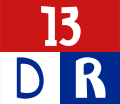
The Cuban Revolution was the military and political effort to overthrow Fulgencio Batista's dictatorship which reigned as the government of Cuba between 1952 and 1959. It began after the 1952 Cuban coup d'état which saw former president and military general, Fulgencio Batista topple the nascent Cuban democracy and consolidate power. Among those opposing the coup was Fidel Castro, then a novice attorney who attempted to contest the coup through Cuba's judiciary. Once these efforts proved fruitless, Fidel Castro and his brother Raúl launched armed attack on the Cuban military's Moncada Barracks on July 26, 1953. Following the attack's failure, Fidel Castro and his co-conspirators were detained and formed the 26th of July Movement (M-26-7). At his trial, Fidel Castro launched into a two hour speech that garnered him national fame as he laid out his grievances against the Batista dictatorship. In an attempt to win public approval, Batista authorized amnesty to the surviving Moncada Barracks attackers and forced them into exile. The Castro brothers regrouped abroad with Che Guevara whom they met in Mexico. In 1956 the rebels returned to Cuba upon the Gramna, a yacht whose landing was interrupted by fire from Batista's troops. Guevara and the Castro brothers fled into the Sierra Maestra where the M-26-7 rebel forces would reorganize, conducting urban sabotage and covert recruitment. Over time the originally critical and ambivalent Popular Socialist Party would see its influence and power wane towards the 26th of July Movement. As the movement against Batista escalated, the rebel forces transformed from crude, guerrilla fighters into a cohesive, fighting force that could confront Batista's army in military engagements. By the time the rebels were able to oust Batista, the revolution was being driven by a coalition between the Popular Socialist Party, 26th of July Movement, and the Revolutionary Directorate of March 13.

The 26th of July Movement was a Cuban vanguard revolutionary organization and later a political party led by Fidel Castro. The movement's name commemorates the failed 1953 attack on the Moncada Barracks in Santiago de Cuba, part of an attempt to overthrow the dictator Fulgencio Batista.

The Museum of the Revolution is located in the Old Havana section of Havana, Cuba, in what was the Presidential Palace of all Cuban presidents from Mario García Menocal to Fulgencio Batista. The building became the Museum of the Revolution during the years following the Cuban Revolution. The palace building was attacked by the Directorio Revolucionario 13 de Marzo in 1957.
The Escambray rebellion was an armed conflict from 1959 to 1965 in the Escambray Mountains during which several insurgent groups fought against the Cuban government led by Fidel Castro. The military operation against the rebellion was called the Struggle Against Bandits by the Cuban government.
Víctor Emilio Dreke Cruz is a Cuban Communist Party leader of African descent, and a former commander in the Cuban Revolutionary Armed Forces.

William Alexander Morgan was an American-born Cuban guerrilla commander who fought in the Cuban Revolution, leading a band of rebels that drove the Cuban army from key positions in the central mountains as part of Second National Front of Escambray, thereby helping to pave the way for Fidel Castro's forces to secure victory. Morgan was one of about two dozen U.S. citizens to fight in the revolution and one of only three foreign nationals to hold the rank of comandante in the rebel forces. In the years after the revolution, Morgan became disenchanted with Castro's turn to communism and he became one of the leaders of the CIA-supplied Escambray rebellion. In 1961, he was arrested by the Cuban government and, after a military trial, executed by firing squad in the presence of Fidel and Raúl Castro.
Frank País García was a Cuban revolutionary who campaigned for the overthrow of General Fulgencio Batista's government in Cuba. País was the urban coordinator of the 26th of July Movement, and was a key organizer within the urban underground movement, collaborating with Fidel Castro's guerrilla forces which were conducting activities in the Sierra Maestra mountains. País was killed in the streets of Santiago de Cuba by the Santiago police on July 30, 1957.

The Battle of Santa Clara was a series of events in late December 1958 that led to the capture of the Cuban city of Santa Clara by revolutionaries under the command of Che Guevara.
The Cuban Revolution was the overthrow of Fulgencio Batista's regime by the 26th of July Movement and the establishment of a new Cuban government led by Fidel Castro in 1959.

José Antonio Echeverría Bianchi was a prominent figure in the Cuban Revolution against President Fulgencio Batista. Echeverría was the President of the Federation of University Students and a founding member of the militant organization Directorio Revolucionario 13 de Marzo. He is known for his role in the attack on the Presidential Palace and the Radio Reloj radio station of Cuba. Echeverría's nickname was "Manzanita," which means "Little Apple."

Eloy Gutiérrez Menoyo was a revolutionary who led the guerrilla force Second National Front of Escambray during the Cuban Revolution against Fulgencio Batista and later opposed the government of Fidel Castro over its pro-Soviet leanings. His brother Carlos Gutiérrez Menoyo died in the Presidential Palace attack of March 13, 1957.
The Directorio Revolucionario Estudiantil was a Cuban student activist group launched in opposition to Fidel Castro in 1960, based at the United States, where it soon developed links with the Central Intelligence Agency. In August 1962 it carried out an attack on a beachfront Havana hotel. As of 1963, it was the largest anti-Castro student group in Miami; it also had a chapter in New Orleans, where it had contact with Lee Harvey Oswald in mid-1963. Immediately after the November 22, 1963 assassination of John F. Kennedy, it launched a campaign asserting that Lee Harvey Oswald had been acting on behalf of the Cuban government. The group lost its CIA support in December 1966.
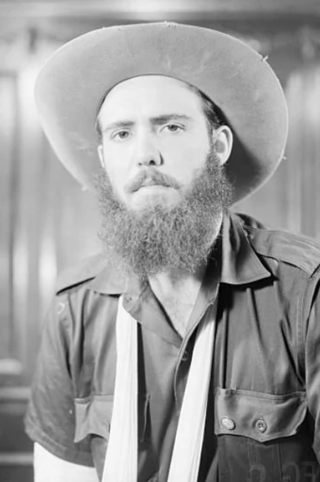
Rolando Cubela Secades was a Cuban revolutionary leader who played a vital part in the Cuban Revolution, having been a founding member of the Directorio Revolucionario Estudiantil and later the military leader of the DRE's Escambray Mountain front, achieving the rank of Commander, the highest military rank in the Revolutionary Army. After the Revolution succeeded in 1959, Cubela became Cuba's envoy to UNESCO. Under the cryptonym AM/LASH, Cubela became "an important asset" of the Central Intelligence Agency, and worked with them on plots to assassinate Fidel Castro. In 1966, Cubela was arrested for plotting the assassination of Castro, and sentenced to 25 years in prison. Released in 1979, he went into exile in Spain.
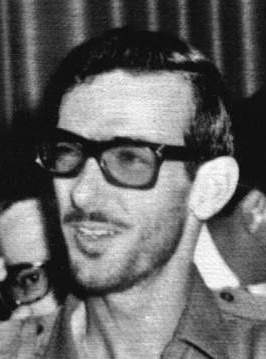
Second National Front of Escambray was an independent guerilla group led by Eloy Gutiérrez Menoyo and Dr. Armando Fleites and included Roger Redondo, Ramiro Lorenzo, Jorge Castellón, Jesús Carreras Saya, Lázaro Artola, Genaro Arroyo, and others in the Cuban central Escambray Mountains. William Alexander Morgan was also a part of the Escambray group. While initially the group supported Fidel Castro in his efforts to overthrow Cuban dictator Fulgencio Batista, after Castro took power some of its members joined former Batista soldiers and local farmers in the Escambray Rebellion (1959–1965) opposing Castro.

The 1957 Havana Presidential Palace attack was a failed assassination attempt on the life of President Fulgencio Batista at the Presidential Palace in Havana, Cuba. The attack began at around 3:30 pm on March 13, 1957, carried out by Menelao Mora, a group of members of the Partido Auténtico, and the student opposition group Directorio Revolucionario 13 de Marzo, but was unsuccessful in its goal of killing Batista. According to one of the group's founding members, Faure Chomón, they were following the golpe arriba strategy and sought to overthrow the government by killing Batista.

The Radiocentro CMQ Building complex is a former radio and television production facility and office building at the intersection of Calle L and La Rampa in El Vedado, Cuba. It was modeled after Raymond Hood's 1933 Rockefeller Center in New York City. With 1,650 seats, the theater first opened on December 23, 1947, under the name Teatro Warner Radiocentro, it was owned by brothers Goar and Abel Mestre. Today the building serves as the headquarters of the Cuban Institute of Radio and Television (ICRT).
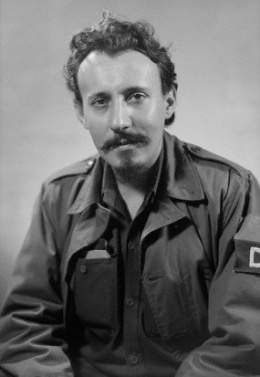
Faure Chomón Mediavilla was a Cuban historian and politician. He was one of the founding members and leaders of the Directorio Revolucionario 13 de Marzo. After the triumph of the Revolution he joined Fidel Castro's government. Early in his career, he served as the Secretary of Communication and Transportation and Ambassador to the Soviet Union. Later he served as Ambassador to Vietnam and Ecuador as well as historian of the Revolution. He was also member of the National Assembly of People's Power from 1976 to his death.
Pico San Juan is the highest point of the central area of the island of Cuba with 1,140 meters above sea level.
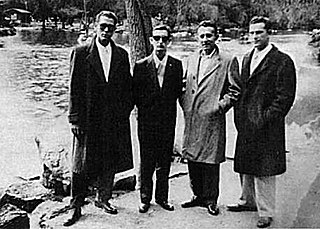
The Humboldt 7 massacre was the extrajudicial killing of four armed Directorio Revolucionario (DR) members by the Havana police on 20 April 1957. The police, led by Lt. Colonel Esteban Ventura Novo, entered apartment 201 of Humboldt 7, a residential building, where the DRE members were hiding. The four men who were killed during the incident had taken part in the Havana Presidential Palace attack and the seizure of the Radio Reloj station at the Radiocentro CMQ Building.

Osvaldo Ramírez García was a Cuban revolutionary and anti-communist rebel. He was a member of the Revolutionary Directorate of 13 March Movement, involved in the overthrow of the Batista regime, and later was involved in the armed resistance to Fidel Castro. He was a member of the National Revolutionary Police Force and after the break with Castro, he was commander of an anti-communist rebel formation, one of the leaders of the Escambray Rebellion. He was killed during the rebellion by government forces.






